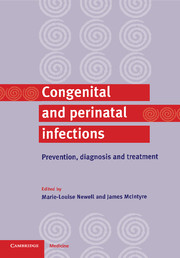Book contents
- Frontmatter
- Contents
- List of contributors
- Preface
- Part I General issues
- Part II Specific infections
- 5 Rubella infection in pregnancy
- 6 Perinatal Group B streptococcal infections
- 7 Mother-to-child transmission of cytomegalovirus
- 8 Varicella
- 9 Herpes simplex
- 10 Vertical transmission of hepatitis viruses
- 11 Papillomavirus infections as a perinatal problem: diagnosis, prevention and management
- 12 HIV-1 infection
- 13 Syphilis: prevention, diagnosis and management during pregnancy and infancy
- 14 The other sexually transmitted diseases
- 15 Toxoplasmosis
- 16 Neonatal sepsis
- Index
15 - Toxoplasmosis
Published online by Cambridge University Press: 06 July 2010
- Frontmatter
- Contents
- List of contributors
- Preface
- Part I General issues
- Part II Specific infections
- 5 Rubella infection in pregnancy
- 6 Perinatal Group B streptococcal infections
- 7 Mother-to-child transmission of cytomegalovirus
- 8 Varicella
- 9 Herpes simplex
- 10 Vertical transmission of hepatitis viruses
- 11 Papillomavirus infections as a perinatal problem: diagnosis, prevention and management
- 12 HIV-1 infection
- 13 Syphilis: prevention, diagnosis and management during pregnancy and infancy
- 14 The other sexually transmitted diseases
- 15 Toxoplasmosis
- 16 Neonatal sepsis
- Index
Summary
Introduction
Toxoplasma gondii occurs throughout the world and is one of the most common parasitic infections of humans. Infection is acquired by ingestion of viable tissue cysts in undercooked meat, or of oocysts excreted by cats and contaminating soil or water (Remington et al., 1995). Acquisition of toxoplasma infection for the first time (primary infection) is usually asymptomatic although a significant minority of people suffer fever, malaise and lymphadenopathy (Ho-Yen, 1992a). As the primary infection resolves, the parasite forms latent cysts throughout the body. In approximately 1% or less of people infected with T. gondii, latent cysts in the retina and choroid can reactivate, often years after infection, and give rise to inflammatory lesions, which may affect vision (Gilbert & Stanford, 2000). Toxoplasma infection is a major cause of morbidity and mortality in immunodeficient patients (Ho-Yen, 1992b).
When primary infection occurs during pregnancy, T.gondi may be transmitted from the mother to the fetus. Fetal infection can result in inflammatory lesions in the brain, retina and choroid that may lead to permanent neurological damage and visual impairment. Rarely, disseminated fetal infection causes fetal or postnatal death. Approximately 1–10 per 10,000 babies are born with congenital toxoplasmosis (Ancelle et al., 1996; Conyn-van-Spaedonck, 1991; Guerina et al., 1994; Lebech et al., 1999).
How best to prevent symptoms and disability due to congenital toxoplasmosis is a question that has caused controversy among clinicians for the last three decades. At the core of the debate is uncertainty about the effectiveness of prenatal treatment on the risk of congenital toxoplasmosis, and of prenatal and postnatal treatment on the risk of clinical signs and symptoms in the long term.
- Type
- Chapter
- Information
- Congenital and Perinatal InfectionsPrevention, Diagnosis and Treatment, pp. 305 - 320Publisher: Cambridge University PressPrint publication year: 2000
- 2
- Cited by



